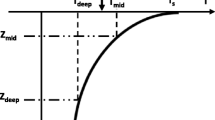Abstract
The mathematical analogy between ground water flow and electrical flow has been recognized for decades. This analogy is used to illustrate how input data for the ground water flow model MODFLOW can be scaled and used to simulate the two-dimensional flow of electricity through conductive contaminant plumes in porous media. MODFLOW is used to simulate electrical potential fields generated at the land surface by mise-a-la-masse surveys for several simplified contaminant plumes. These simulations illustrate the degree of “visual” distortion in the electrical potential fields that can be expected for various plume conditions. In addition, the simulations show that a conductive contaminant plume will depress the electrical potential field below preplume baseline conditions near the plume. Depression of the electrical potential field near conductive, ground water contaminants is significant from the standpoint of early detection of leaks from waste disposal facilities.
Similar content being viewed by others
References
Anderson, P.F. 1988. PREMOD (a preprocessor for MODFLOW). Geotrans, Inc. Reston, Virginia.
Archie, G.E. 1942. The electrical resistivity log as an aid in determining some reservoir characteristics. Am. Inst. Min. Metallurg. Pet. Eng. Tech. Paper 1422, pp. 146–154.
Bear, J. 1972. Dynamics of fluids in porous media. Dover Publications, Inc. New York, 764 p.
Bermes, B.J. 1960. An electric analog method for use in quantitative hydrologic studies. U.S. Geol. Surv., Phoenix, Arizona, unpublished manuscript.
Biella, G., Lozej, A., and Tabacco, I., (1983), Experimental study of some hydrogeophysical properties of unconsolidated porous media. Ground Water, v. 21, no. 6, pp. 741–751.
Davis, S.N., and DeWiest, R.J.M., (1966), Hydrogeology, John Wiley and Sons, New York, 463p.
Dey, A., and Morrison, H. F. (1979), Resistivity modeling for arbitarily shaped three-dimensional structures. Geophysics, v. 44, no. 4, pp. 753–780.
De Marsily, G. (1986), Quantitative Hydrogeology, Ground water Hydrology for Engineers, Academic Press, Inc., Orlando, 440p.
Freeze, R.A., and Cherry, J.A., 1979. Groundwater. Prentice-Hall, Englewood Cliffs, 604p.
Griffiths, D.J. 1989. Introduction to electrodynamics. 2nd edition, Prentice-Hall, Englewood Cliffs, 532p.
Heigold, P.C., Gilkeson, R.H., and Reed, P.C. (1979), Aquifer transmissivity from surficial electrical methods. Ground Water, v. 17, no. 4, pp. 338–345.
Hubbert, M.K., (1940), The theory of groundwater motion. Journal of Geology, v. 48, pp. 785–944.
Karplus, W.J. (1958). Analog simulation. McGraw-Hill, New York, 434p.
Karplus, W.J., and Soroka, W.W. (1959), Analog methods, McGraw-Hill, New York, 483p.
Kelly, W.E. 1977. Geoelectrical sounding for estimating aquifer hydraulic conductivity. Ground Water, v. 15, no. 6, pp. 421–425.
Kosinski, W.K., and Kelly, W.E. (1981), Geoelectric soundings for predicting aquifer properties. Ground Water, v. 19, no. 2, pp. 163–171.
Lorra, P., Corson, D. R. and Lorrain, F., (1988), Electromagnetic Fields and Waves. W.H. Freeman and Company, New York, 754p.
Mazac, O., Kelly, W. E. and Landa, I. (1985), A hydrogeophysical model for relations between electrical and hydraulic properties of aquifers, Journal of Hydrology, v. 79, pp. 1–19.
McDonald, M.G., and Harbaugh, A. W. (1988), A modular three-dimensional finite-difference ground-water flow model, Chapter, A1, Book 6, Techniques of Water-Resources Investigations of the U.S. Geol. Survey.
Mualem, Y. and Friedman, S.P., (1991), Theoretical prediction of electrical conductivity in saturated and unsaturated soil. Water Resources Research, Vol. 27, No. 10, pp. 2771–2777.
Osiensky, J.L. and Donaldson, P. R., (1994), A modified mise-a-la-masse method for contaminant plume delineation. Ground Water, v. 32, no. 3, pp. 448–457.
Parasnis, D.S., (1967), Three-dimensional electric mise-a-la-masse survey of an irregular lead-zinc-copper deposit in central Sweden. Geophys. Prosp., V. 15, No. 3, pp. 407–437.
Parkhomenko, E.I., (1967), Electrical properties of rocks, Monographs in Geoscience, Plenum Press, New York, 314p.
Prickett, T.A., (1975), Modeling techniques for groundwater evaluation. Advances in Hydroscience, V. 10, pp. 1–143.
Telford, W.M., Geldart, L. P., and Sheriff, R. P., (1990), Applied Geophysics (2nd Ed.), Cambridge University Press, Cambridge, 770p.
Thiem, G., (1906), Hydrologische methoden: Leipzig. J.M. Gebhart, 56p.
Urish, D.A., (1981), Electrical resistivity-hydraulic conductivity relationships in glacial outwash aquifers. Water Resources Research, v. 17, no. 5, pp. 1401–408.
Walton, W.C., (1970), Groundwater resource evaluation. McGraw-Hill, New York, 664p.
Author information
Authors and Affiliations
Rights and permissions
About this article
Cite this article
Osiensky, J.L., Williams, R.E. Finite-difference simulation of the application of electrical flow through conductive contaminant plumes. Mine Water and the Environment 14, 39–56 (1995). https://doi.org/10.1007/BF02914852
Issue Date:
DOI: https://doi.org/10.1007/BF02914852




